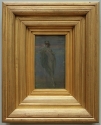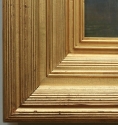The Paintings of James McNeill Whistler
YMSM 318
Ariel

Date
Ariel dates from between 1884 and 1886. 1

Ariel, The Hunterian
1884: It may have been inspired by the open-air theatricals put on by Archibald Campbell (1846-1913) and Lady Janey Sevilla Campbell (Lady Archibald Campbell) (ca 1846-d.1923). Note in Green and Brown: Orlando at Coombe y317 depicts Lady Archie as Orlando in Shakespeare's As You Like It. Although less explicit in its origin than Whistler's painting of Orlando, it is possible that Ariel likewise dates from 1884.
1885/1888: The butterfly signature suggests a slightly wider or later date, possibly between 1885 and 1888.

Sketch for 'Annabel Lee', The Hunterian
The exaggerated pose and composition suggest a link with Sketch for 'Annabel Lee' y080, which in itself is hard to date, being a reworking of an earlier composition.

Le ruban, The Hunterian
Similar colours – pale blue and turquoise, pale green, and yellow ribbons – are similar to those in a pastel of a young woman called Le ruban m1381 that has been tentatively dated 1893; but again, it is difficult to date.
Images

Ariel, The Hunterian

Ariel, The Hunterian

Ariel, frame detail

Sketch for 'Annabel Lee', The Hunterian

Le ruban, The Hunterian
Subject
Titles
Whistler's original title is not known. Only one title has been suggested:
- 'Ariel' (1905, Œuvres de James McNeill Whistler, Paris). 2
- 'Ariel' (1936, University of Glasgow). 3
- 'Ariel' (1980, YMSM). 4
It may be that the one known title 'Ariel' was mentioned by Whistler to his sister-in-law and executrix, Rosalind Birnie Philip (1873-1958). If indeed the title dates back to Whistler's time, then it is one of only three literary titles given by Whistler to his paintings, the other two being Annabel Lee y079 and Arrangement in Yellow and Grey: Effie Deans y183). In the case of Ariel, the title is derived from Shakespeare's play The Tempest.
Description

Ariel, The Hunterian
A small panel in vertical format, showing a slim young woman leaning back against a yellow railing in front of the sea. She leans very far to left, her right leg advancing in front of her left, in a dramatic but inherently unstable position. She wears a transparent gauze robe. A pale green cloak hangs behind her, clasped round her shoulders. She appears to be looking down, fastening the cloak over her chest. There is a dull green scarf around her head, tied with a yellow ribbon that falls down over her right side.
The foreground beach, dotted with pale yellow flowers or stones, merges imperceptibly into the sea, so that it looks more as if she is standing on a beach than a promenade or balcony, but the extreme position in which she stood could not be convincingly maintained without a railing.
Site
The composition does suggest the setting of Ariel's song in Act 1, Scene 2, of Shakespeare's The Tempest :
'Come unto these yellow sands, / And then take hands: / Courtsied when you have and kiss'd / The wild waves whist, / Foot it featly here and there; / And, sweet sprites, the burthen bear. / Hark, hark!'
Sitter
Whistler's model is unknown.
In Shakespeare's The Tempest, Ariel was an airy spirit imprisoned by the witch Sycorax in a cloven pine and released by the magic of Prospero, Duke of Milan, who employed Ariel to carry out his schemes. The cloak may be Prospero's magic cloak, rendering Ariel invisible.
Technique
Composition

Ariel, The Hunterian

Sketch for 'Annabel Lee', The Hunterian
The exaggerated pose of the figure, the composition, with a railing over the sea, some of the colours, and particularly the treatment of the sky, suggest a link with Sketch for 'Annabel Lee' y080, which may be a reworking of an earlier composition. As the 1980 catalogue commented:
'The actual subject of a draped figure on a balcony with leaves, and the sea beyond, resembles the 'Six Projects' (Venus y082 et seq.) and is a constantly recurring theme in Whistler's work.' 5
Technique

Ariel, The Hunterian
It is painted on a wood panel that has a strong grain, and was primed with white. A paint sample, taken from the sky, includes lead white, Prussian blue, natural ultramarine, bone black and yellow ochre. The paint medium is more likely a megilp than a thinned paint or one with added sauce. 6
The brushwork is very fluid. There appear to have been several changes to the pose of the figure, with signs of alterations around the head and legs. The background sea and sky was painted right up to the figure, mainly in horizontal strokes. The railings were then painted over the sea.
Conservation History
It is painted on a panel with auxiliary backing and a framing device, both made from mahogany-type hardwood; the framing device consists of four thin battens with mitred corners, slightly bevelled on the verso, and attached to the panel with glue. It is likely that this was made after Whistler's death. There are vertical cracks down the panel, to left of the figure. The edges of the panel may have been damaged and retouched. There is some craquelure along the wood grain. The varnish is thick and glossy and almost certainly not original; it was probably applied when the panel was repaired and retouched. 7
Frame

Ariel, The Hunterian

Ariel, frame detail
A Grau-style frame, dating from the 1890s, 46.9 x 37.5 x 6.6 cm. 8
History
Provenance
- 1903: in Whistler's studio at his death, and bequeathed to his ward and executrix, Rosalind Birnie Philip (1873-1958);
- 1935: given by Miss R. Birnie Philip to the University of Glasgow.
It was seen by Charles Lang Freer (1856-1919) in Whistler's studio at some time around 1900. He noted that he had seen two versions of 'Annabel Lee' (Annabel Lee y079 and Sketch for 'Annabel Lee' y080), 'and another still smaller and very lovely one greenish drapery and wonderful sky ... yellow line behind her', which must have been Ariel. 9
Exhibitions
It was not, as far as is known, exhibited in Whistler's lifetime.
Due to the terms of Miss R. Birnie Philip's gift to the University of Glasgow, it is not lendable.
Bibliography
Catalogues Raisonnés
- Young, Andrew McLaren, Margaret F. MacDonald, Robin Spencer, and Hamish Miles, The Paintings of James McNeill Whistler, New Haven and London, 1980 (cat. no. 318), plate 219, as 'Ariel'.
Authored by Whistler
- None.
Catalogues 1855-1905
- Œuvres de James McNeill Whistler, Palais de l'Ecole des Beaux-Arts, Paris, 1905 (cat. no. 50) as 'Ariel'.
Journals 1855-1905
- None.
Monographs
- None.
Books on Whistler
- Cary, Elizabeth Luther, The Works of James McNeill Whistler: A Study, with a Tentative List of Artist’s Works, New York, 1907, p. 191 (cat. no. 210).
- Sickert, Bernhard, Whistler, London and New York, 1908, p. 170 (cat. no. 143).
- Sutton, Denys, Nocturne: The Art of James McNeill Whistler, London, 1963, p. 77.
Books, General
- Studing, Richard, Shakespeare in American Painting. A Catalogue from the late eighteenth century to the present, Farleigh Dickinson University Press, Rutherford, Madison, 1993, p. 139 (cat. no. 868).
Catalogues 1906-Present
- James McNeill Whistler, University of Glasgow, Glasgow, 1936 (cat. no. 14).
- Whistler and Mallarmé, Hunterian Museum, University of Glasgow, 1973 (cat. nos. 31-32).
- Getscher, Robert H., 'Whistler's Puritanical Nudes', in Zelman, Anita, and Angela De Tolla-Smyth, A Symposium Window on Whistler's World, Held in Conjunction with Drawing Near: Whistler Etchings from the Zelman Collection, 15 September 1984, Los Angeles County Museum of Art, Graphic Arts Council; Los Angeles County Museum of Art, American Art Council, Los Angeles, 1984, p. 91.
- MacDonald, Margaret F., Whistler Pastels and Related Works in the Hunterian Art Gallery, Hunterian Art Gallery, University of Glasgow, 1984, p. 25.
- Hopkinson, Martin, From Apprentice to Master: Whistler's Graphic Art, Hunterian Art Gallery, Glasgow, 1992 (cat. no. 18).
Journals 1906-Present
- None.
Websites
- The Hunterian website at http://collections.gla.ac.uk/#/details/ecatalogue/41144.
- Art UK website at https://artuk.org.
Unpublished
- Revillon, Joseph Whistler, Draft Catalogue Raisonné of the Paintings of J. McN. Whistler, [ca 1945-1955], Glasgow University Library (cat. no. 267).
Other
- None.
Notes:
1: Dated 'about 1884' in YMSM 1980 [more] (cat. no. 318).
2: Œuvres de James McNeill Whistler, Palais de l'Ecole des Beaux-Arts, Paris, 1905 (cat. no. 50).
3: James McNeill Whistler, University of Glasgow, Glasgow, 1936 (cat. no. 14).
4: YMSM 1980 [more] (cat. no. 318).
5: YMSM 1980 [more] (cat. no. 318).
6: Dr Joyce H. Townsend, Tate Britain, Report of Examination, July 2017.
7: Townsend 2017, op. cit., and Clare Meredith, condition report, 5 April 2001, Hunterian files.
8: Dr S. L. Parkerson Day, Report on frames, 2017; see also Parkerson 2007 [more].
9: [ca 1900], Diaries, Bk 14, Freer Gallery Archives.
10: Whistler to W. Heinemann,[31 January 1898], #10803.